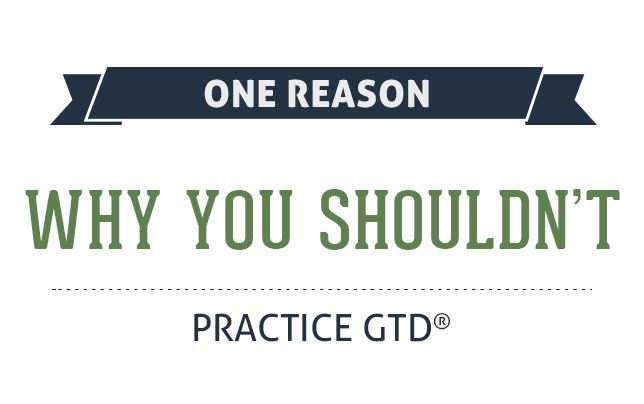Yes.
You read that right.
Even though I’ve been practicing GTD for 10+ years, I’ve come to think that there’s a good reason why GTD may not be right for you.
The thing is, GTD will not work for you if you’re addicted to Stress. And you’ll not get any of the fabled results.
Now you might be wondering, why would anyone be addicted to stress?
And is stress a bad thing? Don’t we perform better when we’re under stress?
Before we explore this topic further, it is important to establish distinctions between the two types of stress we experience.
The Two Types of Stress. One Good. One Bad.
Stress is not necessarily a bad thing. Stress is simply the body’s response to changes that create taxing demands.
You experience positive stress when you feel motivated to bridge the gap between where you are and where you want to be. It’s this kind of stress that makes you jump out of your bed in the morning to work on your projects.
Positive stress helps us push boundaries, set our sights higher and accomplish more than what we think is possible.
David Allen, the founder of GTD says, “I think positive stress is actually a good thing. It’s sort of the stretch goal “Wow, let me see how much faster I can run” or “Let me see how many more ideas I can generate in five minutes.”
It is negative stress that we need to watch out for because this stress puts our body in fight or flight mode.
We are negatively stressed when we mismanage our commitments with ourselves. When we say “Yes” to something but are not able to complete it.
An Important report needed by tomorrow morning? And it’s not yet ready?
Negative Stress. Because you let your boss down.
Forgotten anniversary?
Negative Stress. Because you let your spouse down.
Not going to the gym, even though you bought an Annual membership?
Negative Stress. You let yourself down.
But negative stress also comes with a surprising side effect. It gives the impression that you are juggling complicated and almost impossible things that do require you to be on your toes all the time.
And some people end up loving this sense of importance.
GTD takes away the ground on which negative stress stands.
How the 5 Steps of GTD Eliminate Stress
With Getting Things Done® you:
Capture out of your head all the tasks that have your attention so that you can take an accurate inventory of exactly how much you have on your plate and also commit the list to a reliable external memory – one that doesn’t let you down! This frees up room for creative thinking and lets you stick to your commitments, or renegotiate them if needed.
Clarify everything you’ve captured, by getting clear what it means to you and what needs to be done about it. This step gets you to define what success looks like for the tasks and asks the question, “What is the Next Action?”. With this technique, you beat procrastination for good because you know exactly what to do next and what the consequence of not making progress is.
Organize your Next Actions into clear categories so that you never remember to buy eggs when you are presenting to the board of directors and are always ready to make the most of your time and resources.
Reflect periodically on your commitments. Because of habits like the Weekly Review you have room to maneuver in your schedule and are ready to tackle surprises or disruptions like a champ. Imagine feeling prepared under all circumstances? Bye bye fire fighting!
Engage in the tasks that are your priority. GTD’s Horizons of Focus model gives you a crystal clear idea of your “why” and you can confidently execute tasks that take you ever closer to your purpose.
These five steps when followed diligently lead to astonishing results.
I have gone from being a stressed out email junkie to managing multiple organizations and writing four books.
Others like Vasumathi have beaten procrastination and a deep feeling of overwhelm.
In short – GTD works. But only if you’re willing to give up that feeling of importance which comes with negative stress and needless busyness.
Secret to Making GTD a Habit: Lower Your Tolerance For Negative Stress
David believes, “The biggest problem for most people… is their addiction to that level of stress. They’re not uncomfortable enough with that stuff banging around in their head and that sense of overwhelm.”
So the bottom line is, if you are itching to experience increased success in all your undertakings with a calmness you have never felt before, you have to lower your tolerance to stress.
The more you’re OK with tracking your commitments in your mind and mismanaging them, the more difficult it will be to follow GTD.
When you become aware that you don’t have to have negative stress to get things done, the GTD steps will become second nature to you.
You’ll ultimately realize that the creativity and quality output you can enjoy when relaxed beat the hype of stress any day.
That is when GTD – The Art of Stress-Free Productivity will become your best friend.
I believe our work should be an expression of our most creative selves. I work with business owners and their teams to achieve stress-free productivity.

